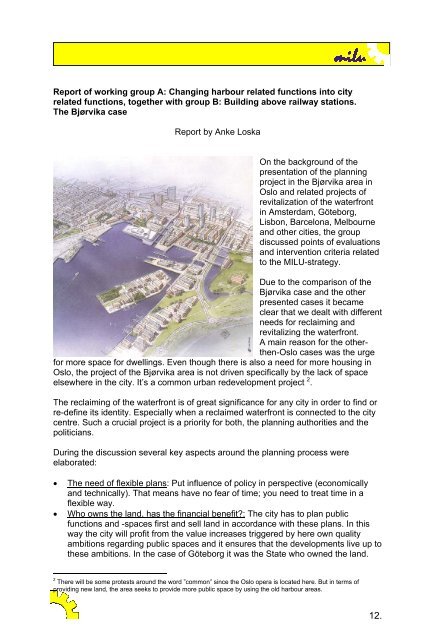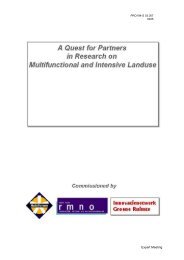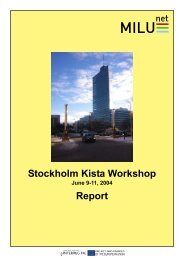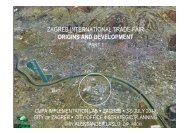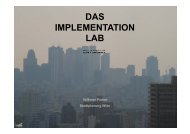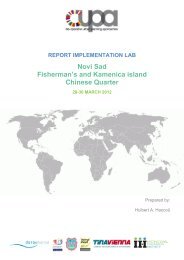2001-June 6-8 MILU - Iiinstitute.nl
2001-June 6-8 MILU - Iiinstitute.nl
2001-June 6-8 MILU - Iiinstitute.nl
Create successful ePaper yourself
Turn your PDF publications into a flip-book with our unique Google optimized e-Paper software.
Report of working group A: Changing harbour related functions into city<br />
related functions, together with group B: Building above railway stations.<br />
The Bjørvika case<br />
Report by Anke Loska<br />
On the background of the<br />
presentation of the planning<br />
project in the Bjørvika area in<br />
Oslo and related projects of<br />
revitalization of the waterfront<br />
in Amsterdam, Göteborg,<br />
Lisbon, Barcelona, Melbourne<br />
and other cities, the group<br />
discussed points of evaluations<br />
and intervention criteria related<br />
to the <strong>MILU</strong>-strategy.<br />
Due to the comparison of the<br />
Bjørvika case and the other<br />
presented cases it became<br />
clear that we dealt with different<br />
needs for reclaiming and<br />
revitalizing the waterfront.<br />
A main reason for the otherthen-Oslo<br />
cases was the urge<br />
for more space for dwellings. Even though there is also a need for more housing in<br />
Oslo, the project of the Bjørvika area is not driven specifically by the lack of space<br />
elsewhere in the city. It’s a common urban redevelopment project 2 .<br />
The reclaiming of the waterfront is of great significance for any city in order to find or<br />
re-define its identity. Especially when a reclaimed waterfront is connected to the city<br />
centre. Such a crucial project is a priority for both, the planning authorities and the<br />
politicians.<br />
During the discussion several key aspects around the planning process were<br />
elaborated:<br />
• The need of flexible plans: Put influence of policy in perspective (economically<br />
and technically). That means have no fear of time; you need to treat time in a<br />
flexible way.<br />
• Who owns the land, has the financial benefit?: The city has to plan public<br />
functions and -spaces first and sell land in accordance with these plans. In this<br />
way the city will profit from the value increases triggered by here own quality<br />
ambitions regarding public spaces and it ensures that the developments live up to<br />
these ambitions. In the case of Göteborg it was the State who owned the land.<br />
2<br />
There will be some protests around the word ”common” since the Oslo opera is located here. But in terms of<br />
providing new land, the area seeks to provide more public space by using the old harbour areas.<br />
12.


